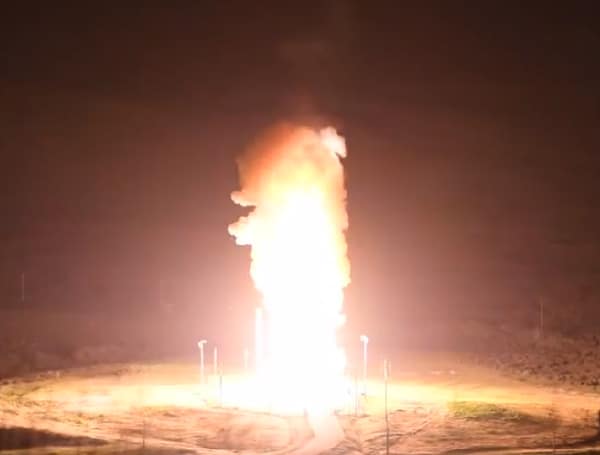A team of Air Force Global Strike Command Airmen launched an unarmed Minuteman III intercontinental ballistic missile equipped with a test reentry vehicle at 11:01 p.m. Pacific Time Feb. 9 from Vandenberg Space Force Base, California.
The launch Pentagon was characterized by the Pentagon as a display of the U.S.’ effective nuclear deterrent against hostile foreign powers.
While the Air Force stressed that such launches have occurred hundreds of times in the past and are not correlated with ongoing world events, it takes place amid recent news of Chinese and North Korean nuclear buildup that could threaten America’s defenses and ability to deter future attacks.
“These test launches demonstrate the readiness of U.S. nuclear forces and provide confidence in the lethality and effectiveness of the nation’s nuclear deterrent,” Col. Bryan Titus, Space Launch Delta 30 vice commander and launch decision authority, said in the statement.
In the news: VIDEO: The Moment An F-22 Raptor ‘Takes Down’ The Chinese Spy Balloon Over South Carolina
The ICBM’s reentry vehicle traveled approximately 4,200 miles to the Kwajalein Atoll in the Marshall Islands. These test launches verify the accuracy and reliability of the ICBM weapon system, providing valuable data to ensure a continued safe, secure and effective nuclear deterrent.
“This launch showcases the redundancy and reliability of our strategic deterrence systems while sending a visible message of assurance to allies,” said Col. Christopher Cruise, 377th Test and Evaluation Group commander.
The head of U.S. Strategic Command (STRATCOM) notified Congress on Jan. 26 that China’s construction of ground-based ICBM launchers had exceeded those operated by the U.S., The Wall Street Journal reported.
Many of those silos are empty, and the U.S.’ total nuclear arsenal, including air, land and sea-based capabilities, is still much larger than China’s, officials said.
However, the news highlighted China’s rapidly expanding nuclear arsenal and concurrent U.S. efforts to modernize its nuclear triad. The Pentagon intends to replace the Minuteman III ICBMs with the LG-35A Sentinel by 2029, the Air Force said.
Thursday’s ICBM launch was months in the works and involved planning from the Department of Defense, Department of Energy, and STRATCOM, according to the Air Force.
“A test launch displays the heart of our deterrence mission on the world’s stage, assuring our nation and its allies that our weapons are capable and our Airmen are ready and willing to defend peace across the globe at a moment’s notice,” Gen. Thomas A. Bussiere, Air Force Global Strike Command commander, said.
In the news: Rep. Gaetz Files Bill To Urge Peace In Ukraine, Citing U.S. “Fatigue”
North Korea showed off a massively expanded intercontinental ballistic missile (ICBM) arsenal capable of ferrying nuclear warheads to the U.S. in a Wednesday-night parade. North Korea had never displayed that many nuclear-capable missiles at once, signaling the country’s resolve to achieve “tremendous nuclear strike capability,” state media said, and overpower U.S. defenses, according to the WSJ.
Photos of the parade demonstrated potential further advancements, including launch vehicles specified for solid-fueled ICBMs that adversaries could struggle to identify and intercept, Reuters reported. The vehicles indicate North Korea may be preparing to test the advanced missiles, analysts said.
The U.S. operates 44 ground-based interceptors on its western coastline intended to destroy incoming IBCMs, according to the Missile Defense Agency. However, if North Korea could fit four warheads on each missile, it could potentially overwhelm U.S. defenses.
In the news: US Officials Say Chinese Spy Balloon Was Able To Monitor Communication Signals
In addition to working on upgrades to aging nuclear capabilities, the U.S. has made efforts to deepen military cooperation with South Korea and Japan to ward off potential aggression from perceived threats from China and North Korea, Politico reported.
Android Users, Click Here To Download The Free Press App And Never Miss A Story. Follow Us On Facebook Here Or Twitter Here. Signup for our free newsletter by clicking here.

